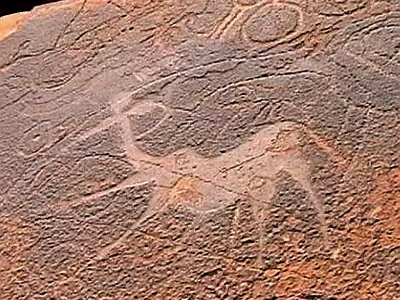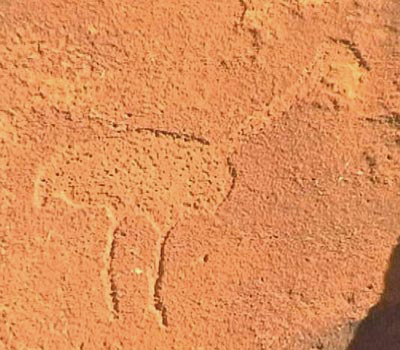 |
 |
APPENDIX 2 - TWYFELFONTEIN SITE REPORT BY SVEN OUZMAN |
8/18 |
| |
|
Site 8 – Twyfelfontein Main Site Complex |
Die grosse Wohnfläche
Site C on Scherz’s Map (C in
Figure 14)
S 20° 35’ 36’’ / E 14° 22’ 30”
Site Description
Immediately above the spring on the 660m contour there is a large, flat, sand-covered mini-plateau that makes for an excellent living area. This flat area is fringed by large rock blocs, two of which occur on the plain area as rock shelters, one of which is a large mushroom-shaped outcrop and the other a squatter but deeper shelter with Bushman rock paintings. Upslope to the south-east there is an arched cave-like space with Bushman rock engravings and a rock painting. There is also a shelter upslope and on the north-eastern edge of the flat area. The rest of the area has Bushman and Khoekhoen rock engravings. The view is very localised unless one goes to the edges of the flat area and gazes west over the valley.
Associated Archaeology
Though disturbed by the construction of the visitor’s path and illegal sampling by visitors, there remains a great deal of surface archaeology in the form of hornfels and quartzite stone tools of every description; especially in the less-visited off-path areas; ostrich eggshell fragments and so forth. There are also a number of surviving semi-circular, circular and oval small (diameter of 1m – 1.5m) stone circles that have been made by placing thin pavement-like stone slabs on their edges. These stone circles may represent Khoekhoen architecture. The painted rock shelter was excavated by Dr. Eric Wendt and was filled with cultural material to a depth of about 400mm.
Description of Die grosse Wohnfläche’s rock art
This area has both Bushman rock engravings (50) and rock paintings 43) as well as Khoekhoen rock engravings (70) located in five main locations.
North-eastern rock shelter: At the north-eastern edge of the flat living area there is a high but small rock shelter. At the back and to the side of this shelter on a sloping rock block there is a collection of geometric Khoekhoen imagery – primarily 9 rough pecked-outline circles, a cup-and-ring motif, some wavy lines and half a pecked-outline dumbbell motif.
Fabeltier panel: On the eastern edge of the flat area there is a jumble of large rock blocks and slabs. On one such large slab, sloping at a 40° angle, there is one of Twyfelfontein’s best-known images. This takes the form of a 860mm x 680mm kudu ewe in what has become known as a ‘dancing’ posture (
Figure 79). The kudu has been engraved and then abraded to a smooth polish – a most unusual technique for Bushman rock engravings. A cup-and-ring motif in front of the kudu has been similarly abraded and polished (
Figure 80). A lighter abraded and polished line runs down from the kudu’s snout. The kudu’s tail has been re-engraved and there are at least three geometric motifs placed partially on top of the kudu. The rest of this large image cluster is dominated by geometric imagery – probably Khoekhoen in origin. These geometrics are in the form of rough and fine pecked-outline circles, dumbbell motifs, internally divided circles, a spindly star-like motif, meandering lines, a cup-and-ring motif and six very singular crescent-cupule motifs. These motifs consist of a crescent or ‘new moon’ engraved shape that is surrounded in a circle by 24-27 cupule-like dots, though these are smaller than the typical cupules encountered at Twyfelfontein. The geometric imagery has variable patination, showing that the geometric forms were added to the slab over time. Below this slab there is an arc of 15 pecked-outline circles, other geometrics.
Adjacent rock blocks: Immediately west of the Fabeltier site there is an upright rock jumble on the back, western side of which is engraved a rare human figure, two ostrich in rough pecking as well as further geometrics and a possible human footprint engraving.
Zwei Schneider rock shelter: located centrally and further south from the Fabeltier is an obvious squat mushroom rock with quite a large area of overhang with a convex shelter wall. On this wall are about 43 Bushman rock paintings, named after the two cross-legged and seated human figures painted in red (
Figure 81). There is a third kneeling red human figure painted with a single bar infibulated penis and busy drawing his bow. Above these there is a row of at least 9 red human figures. One standing human figure has also a drawn bow. There is a nice white giraffe with red dorsal stripe and red patterning marks on the body. Its head is white and rather equid-like. There are then three small goose-stepping and bow-carrying red human figures (
Figure 81: below the bigger “Schneider”). There is a large 370mm ?zebra near 4 red bags and 4 red human figures with Brandberg-like head-dresses. There are two large human figures painted in red. On the shelter’s ceiling there are 7 well-preserved light red antelope torsos and 8 red human figures. On the rock adjacent to the shelter there are some engraved animals.
Archway engraved shelter: Upslope and behind the Zwei Schneider shelter there is a massive leaning rock block at an entrance to a large rock shelter that has an arched and large passageway through it. Inside the shelter there is a rock-painted equid and a pecked-infill giraffe engraving. On the massive rock block outside are engraved a huge 1130mm x 930mm bull giraffe in deep pecked outline and partial pecked infill (
Figure 82). There are also 8 other engraved animals – another giraffe, 4 antelope with twirly horns and thus probably representing kudu, a possible juvenile antelope, and equid and a ?kudu with a rhinoceros-like snout and tail up.
Other imagery: This tends to be quite scattered and located patchily along the western edge and slope of the living area. There are cupules arranged in interesting meandering lines (
Figure 23 and
Figure 24), fine pecked-outline and infill zebra, kudu, a rare row of human figures, ostrich (
Figure 83), feline with twisted perspective pug marks, rhino, giraffe and oryx.
Threat(s) to site: The excavation at Zwei Schneider rock shelter should be backfilled. The Fabeltier slab consists of multiple thin layers of Etjo sandstone that can easily break if stepped on. Any loose slab will, because of its steep angle, eventually fall to the ground. The rock paintings are in a poor - good condition with flaking sandstone being the main concern.
→
A Survey into the Relationship between
Animal-Engravings & Cupules
→
The Rock Art of Twyfelfontein
→
The Rock Art of Namibia
→
The African Rock Art Archive
→
Bradshaw Foundation
Like us on Facebook & Follow us on Twitter to receive news & updates:












